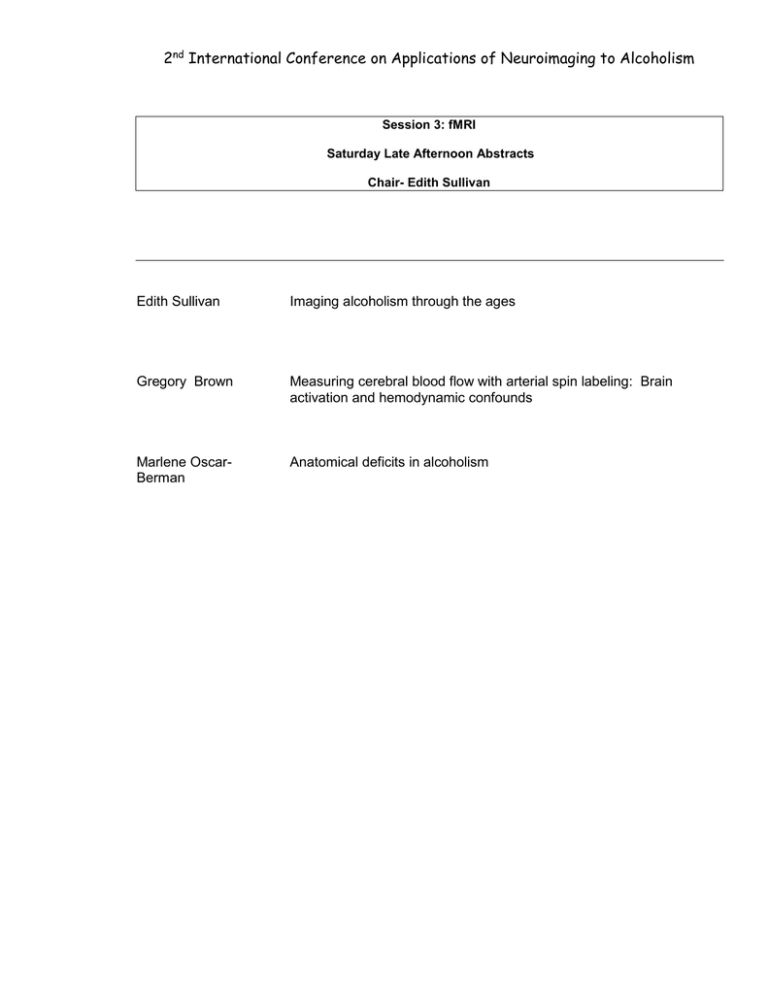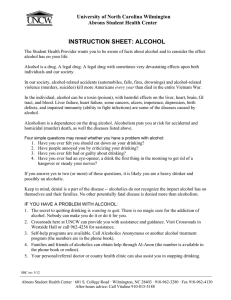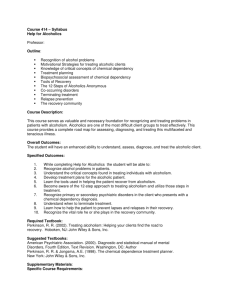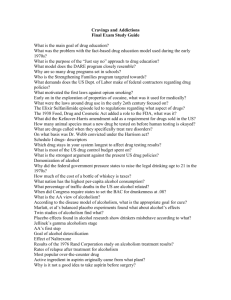ICANA-2 fMRI
advertisement

2nd International Conference on Applications of Neuroimaging to Alcoholism Session 3: fMRI Saturday Late Afternoon Abstracts Chair- Edith Sullivan Edith Sullivan Imaging alcoholism through the ages Gregory Brown Measuring cerebral blood flow with arterial spin labeling: Brain activation and hemodynamic confounds Marlene OscarBerman Anatomical deficits in alcoholism 2nd International Conference on Applications of Neuroimaging to Alcoholism IMAGING ALCOHOLISM THROUGH THE AGES Edith V. Sullivan, Ph.D. The hallmark of alcohol use disorders (AUD), i.e., alcohol abuse, alcohol dependence and "alcoholism", is the chronic excessive consumption of alcohol with the potential for deleterious brain and behavioral outcome. AUDs are not reserved for adults but, unfortunately, are prevalent in the adolescent youth of America and other developed and under-developed nations. Adult alcoholism produces widespread shrinkage of brain tissue and attendant deficits in executive functions, visuospatial abilities, and gait and balance that may foster the selfperpetuating nature of the disorder. Frontocerebellar circuitry disruption is a candidate mechanism of transient and enduring behavioral impairments characteristic of alcoholism. The development and course of alcoholism, its deleterious effects on brain structure and function, and the potential for recovery are influenced by the age at which they occur. The extent to which excessive alcohol consumption alters the course of normal brain, cognitive, and motor development remains a critical consideration, given the extensive neurodevelopmental changes that proceed throughout adolescence and into young adulthood. Many factors have the potential to contribute to the untoward effects of excessive alcohol consumption; some contribute adversely for example, dietary insufficiencies, and others protectively, for example, genetic predisposition to flushing. Gene-environment interactions can also modify behavioral outcomes and can do so differentially depending on the timing of exposure to relevant factors. Structural and functional magnetic resonance imaging (MRI and fMRI) provide noninvasive methods for assessing the condition of the brain's structure and functions, which can be examined contemporaneously and repeatedly in longitudinal study. MR imaging studies have revealed that youth and adults with AUD exhibit similar patterns of structural abnormalities that include frontocerebellar circuitry and interhemispheric connection. Studies using fMRI indicate that adolescent and adult alcoholics recruit higher-order brain systems to accomplish simple tasks that nonalcoholic controls can accomplish by recruiting lower-order brain systems. Although this strategy is useful in compensating for damaged function, it can restrict processing capacity required to engage in multiple tasks simultaneously, thereby resulting in processing inefficiency. Abstinence from alcohol in individuals with AUD can result in improved neurofunction and brain structural integrity, both detectable with MRI and fMRI. The possibility of recovery suggests that either the alcohol-related brain lesion is incomplete and damage reparable or alternative brain systems compensate for damage. Unanswered questions remain regarding the course of recovery and factors modulating it: Is recovery possible in all alcoholics? Does alcoholism adversely affect the course of neurodevelopment? Do recovering alcoholics carry a lifetime burden of emotional change and susceptibility to environmental stimuli engendering craving? Do youth with behavioral disorders and AUD carry compounded liability mitigating against recovery? Indeed, environmental, genetic, metabolic, and behavioral factors that influence restitution of neurofunction have yet to be identified but are amenable to study with MRI and fMRI. With systematic longitudinal study and rigorous characterization of individuals with AUD, neuroimaging can enable in vivo detection and tracking of brain systems affected by alcoholism, the functional relevance of identified neuropathology, the scope and limit of the brain's plasticity at different ages of alcohol exposure and withdrawal, and insight into neural mechanisms of insult and recovery. Support: NIAAA (AA010723) and NIA (AG017919) 2nd International Conference on Applications of Neuroimaging to Alcoholism MEASURING CEREBRAL BLOOD FLOW WITH ARTERIAL SPIN LABELING: BRAIN ACTIVATION AND HEMODYNAMIC CONFOUNDS Gregory G. Brown Arterial spin labeling (ASL) is a magnetic resonance imaging (MRI) method that provides a highly repeatable quantitative measure of cerebral blood flow (CBF). As compared to the more commonly used blood oxygenation level dependent (BOLD) contrast functional MRI method, ASL techniques measure more biologically specific correlates of neural activity, with the potential for more accurate estimation of the location and magnitude of neural function. Recent advances in acquisition and analysis methods have improved the somewhat limited sensitivity of ASL to perfusion changes associated with neural activity. In addition, ASL perfusion measures are insensitive to the low-frequency fluctuations commonly observed in BOLD experiments and can make use of imaging sequences that are purported to be less sensitive than BOLD contrast to signal loss caused by magnetic susceptibility effects. ASL measures of perfusion can aid in the interpretation of the BOLD signal change and, when combined with BOLD, can measure the change in oxygen utilization accompanying changes in behavioral state. Velocity selective ASL can tag blood based on flow velocity. The speaker will present the basic principles behind pulse arterial spin labeling, discuss its use as the primary marker of neural activity in functional brain imaging studies, and give an example of ASL’s role in calibrated functional magnetic resonance imaging. A study of ASL measured CBF in young, alcohol dependent women will be discussed. Sponsored by the VA VISN 22 Mental Illness Research Education and Clinical Center 2nd International Conference on Applications of Neuroimaging to Alcoholism ANATOMICAL DEFICITS IN ALCOHOLISM Marlene Oscar-Berman and Ksenija Marinkovic Results of research employing a variety of different techniques have determined that the brain structures most vulnerable to the effects of chronic alcoholism are the neocortex (especially the frontal lobes), the corpus callosum, the limbic system, and the cerebellum. Recent studies in our laboratory have examined functional and structural brain changes associated with alcoholism, and results have confirmed and extended these findings, especially as related to emotional functioning. For example, in an fMRI study of perception of emotional faces, healthy nonalcoholic control subjects showed robust activation in the amygdala and hippocampus, but these limbic structures were unresponsive in abstinent long-term alcoholics. Measures of activation of prefrontal cortex did not differentiate among the groups until we used more highly emotionally charged stimuli. In that study, the control group showed stronger fMRI activation in dorsolateral and medial prefrontal cortical regions compared to the alcoholic group. We hypothesize that the decreased responsivity in alcoholics may possibly be reflecting dysregulation of brain reward circuitry as a common denominator for many addictions. Of note, our recent MRI morphometric analyses of cortical and subcortical reward-related regions revealed reduced volumes of dorsolateral prefrontal and limbic regions (insula and amygdala), as well as the nucleus accumbens; volume reductions were most pronounced in the right hemisphere. Based principally upon fMRI evidence from our laboratory and others’, we have constructed a figure to represent a schematic summary of the cortical brain regions in which alcoholic and nonalcoholic groups differ with regard to cognition inclusive of working memory, vigilance, and proactive interference. The regions highlighted in the figure were collapsed from the two cerebral hemispheres, and the figure lacks neuroanatomical precision. Nevertheless, in general, the observation of decreased BOLD activation in dorsolateral and medial prefrontal and also parietal areas in alcoholics seems robust. This evidence is in overall agreement with studies showing a decrease in global cortical metabolism and blood flow, especially in frontal areas, using PET, perfusion-weighted MRI, and SPECT methodologies. Furthermore, extensive evidence from structural neuroimaging and neuropathology studies confirms that the frontal lobes are particularly vulnerable to alcohol-related brain damage. However, the activation decrease is not uniform, as alcoholics show increased activity especially in a ventral frontoparieto-cerebellar network. This system may be engaged in order to compensate for deficient dorsolateral prefrontal and parietal contributions and maintain the accuracy of behavioral performance. Regarding brain laterality effects (which are predictably sensitive to stimulus materials and task demands), alcoholics commonly display a pattern of deficits that includes visuospatial, attentional, and emotional abnormalities characteristic of patients with right hemisphere damage. Therefore, the right hemisphere may be more vulnerable to the effects of alcoholism than the left hemisphere. A schematic summary of brain regions in which alcoholic and nonalcoholic groups have been found to differ with regard to cognitive functioning. Supported by the US Department of Health and Human Services, NIAAA (R01-AA07112, K05AA00219, and K01–AA13402), the Medical Research Service of the US Department of Veterans Affairs, and the Alcoholic Beverage Medical Research Foundation.


